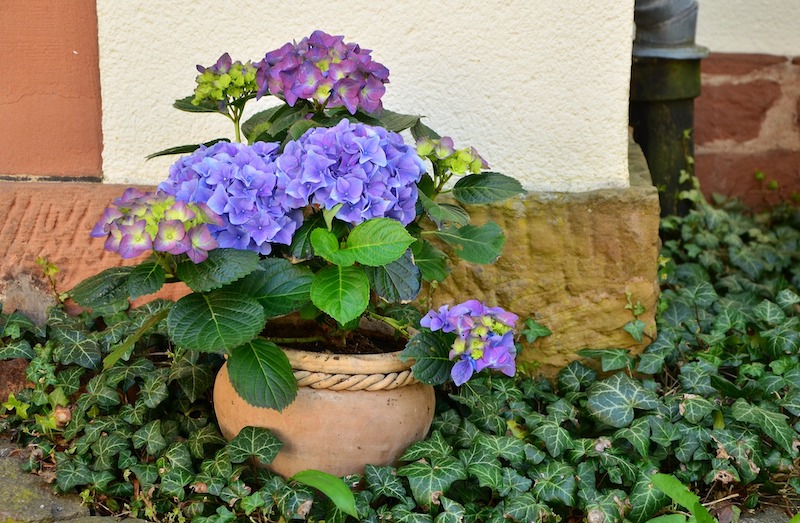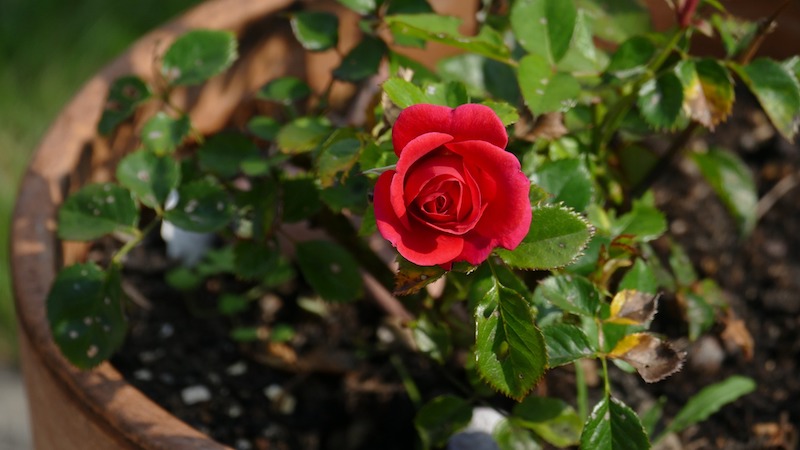Gardeners across North America frequently ask us if they can grow shrubs in containers, and we are happy to say that our answer is always an enthusiastic YES! Garden designers have been doing it for centuries, as it's a perfect way to enjoy year-round beauty and structure anywhere you can set a pot.
Shrubs can be grown in pots and used in many effective ways in the garden. Shrubs can be planted temporarily in containers to add height or foliage interest in a mixed seasonal container and then planted in a garden bed at the end of the season. Other shrubs make wonderful permanent container plantings to be used for a formal look at the front of a house or as screening for privacy around a deck or patio. Here are a few simple guidelines to help assure your success.

Choosing Shrubs to Grow in Planters
Technically speaking, any of our shrubs can be grown in a container. However, if you are planning to keep the shrub in its garden planter all year round, many recommend selecting a plant that is a zone or two hardier than your actual zone (i.e., if you live in zone 5, look for plants that are hardy to zone 3 or 4). This is a very conservative guideline, as it is perfectly possible to be successful with a shrub that is hardy only to your zone, though it does depend somewhat on the plant itself, the container you've selected, and other climatic conditions, such as snow cover, rain, and duration of winter.
Choosing the Best Container
The easiest way to determine the right container to start with is to use the size of the plant that you purchase:
| Pot Size | Container Diameter |
| Quart | 8 - 12" |
| 1 Gallon | 10 - 14" |
| 2 Gallon | 12 - 16" |
| 3 Gallon | 14 - 18" |
| 5+ Gallon | 20" + |
Look for containers that are proportionally high to wide - you want a good volume of soil for the roots to fill. Plus, too small of a container will make watering a real chore. The container must have plenty of open drainage holes in the bottom so that the water will flow freely out instead of backing up in the pot.
Important: Clay and ceramic containers may crack or break when exposed to freezing temperatures, which not only destroys the container but may kill the plant as well. If you live in a cold climate, you must select decorative containers made of materials that can stand up to the weather: plastic, resin fiberglass, wood or metal.
Planting Shrubs in Pots
Shrubs are ready to be planted in the garden early in the spring. Most plants purchased from nurseries are ready to be planted in the garden and do not need extra hardening off. Make sure all the plants you select for a mixed container have the same growing conditions. Sunny shrubs with sun-loving bulbs and annuals will not tolerate shaded porches long before they become leggy and require a brighter location. Ensure that the container has excellent drainage year-round and is weatherproof enough to stay outside in your climate.
It may be tempting to fill your container with old plastic bottles or packing peanuts or other such materials. However, we strongly recommend against this: it does nothing to help drainage and actually decreases the volume of soil available for the roots to grow into, which means you'll have to transplant sooner or water more frequently. Instead, fill the entire volume of the container with a good fresh potting mix. There's no need to look for any kind of fancy potting soil either. Anything that's suitable for containers will work for shrubs.
Tip: If you want to prevent soil from washing out the drainage holes, place a small scrap of newspaper or coffee filter over the holes. This won't hinder the drainage and is very effective at retaining soil.

Best Soil For Shrubs in Pots
Soil-based potting mixes work well for most shrubs. If the shrub is an acid lover like an azalea, rhododendron, or heather, make sure to use an ericaceous mix that will provide the correct micronutrients from the start. Perlite should either be included in the potting mix or be added separately. Perlite ensures the soil drains fast and remains lightweight, so the roots will have no trouble receiving necessary air circulation.
Caring For Shrubs in Planters
Whether the shrub is planted for one season or will remain in the container for many years, the container will need regular maintenance. Potted plants will require more frequent watering and feeding than those growing in the ground. Additionally, container plants are less cold hardy and may require extra winter protection. Read on to learn our best tips for caring for your potted shrub.
Watering Shrubs in Pots
Because of the relatively small volume of soil around the roots, shrubs in containers can dry out quickly and will need frequent watering. The hotter and sunnier the weather, the more water the plant will need. Plan to water at least once a week in cool conditions and three or more times a week in warm or hot weather. There are a few simple ways to check if your plant needs water.
-stick a bamboo stick about 8" into the soil and pull it out. If it comes out dry, water is likely necessary. If it comes out muddy or has moist soil crumbs sticking to it, check it again in a day or two.
-if your pot is not too large or heavy, you can also try lifting it. If it feels very lightweight, water is necessary.
Potted shrubs appreciate natural rainfall and should be placed where they will be watered during a rainstorm. Additional watering is almost always required for potted shrubs. As plants grow in containers, their roots get larger and require more water for adequate support. Check potted shrubs for moisture levels daily during hot, dry spells, especially if the plant is reaching maturity. Do not allow more than the top 3-4 inches of the potting mix to dry completely before irrigating.
Drip irrigation is very beneficial and makes watering easier if you have a large container garden.
Tip: The high peat content in most potting mixes can cause the soil to pull away from the side of the container, so that when you water, it flows down the sides and out the bottom without actually watering the plant. Direct the water to the soil surface rather than the sides, and when you see water coming out the bottom, don't assume you've watered enough. Check the actual soil to see that you have.

Fertilizing Shrubs in Pots
Shrubs in containers will require at least an annual feeding with a granular, slow-release food. Shrubs that flower heavily benefit from a fertilizer with higher P and K numbers than N, such as a formula for roses or tomatoes. For acid-loving plants, such as rhododendrons, camellias, and heathers, use an acidic formula for evergreens. Shrubs grown for foliage will benefit from a more balanced fertilizer with a slightly higher N number. All-purpose shrub fertilizer is fine for them. Apply to the soil surface in the early spring, and the slow-release fertilizer will slowly wash into the soil every time the planter is watered.
Winter Care For Shrubs in Pots
Provided the shrub is hardy (i.e., able to survive winter) in your area, it should stay outdoors all year. Bringing cold tolerant plants indoors for winter is tricky at best: the fresh air, fluctuating temperatures, and changing day length outside all serve as season cues for the plant's life cycle. If you wish, you may move the container with the plant to a sheltered area out of the harshest winds.
Pots left outside in the winter must be weatherproof and not likely to crack or flake from freezing and thawing. Terracotta or glazed ceramic pots will need extra protection in most climates. Resin and plastic planters are durable and best if the shrub is a permanent planting. If your container garden is in an exposed location, such as a roof garden or deck, select plants that are hardy to one or two zones colder than your garden. This ensures the plants will make it through the winter beautifully with little extra maintenance. Planters can also be wrapped in layers of horticultural fabric or burlap to insulate the soil and roots.
Just because a plant has gone dormant for winter does not mean its water needs have disappeared. In warm climates, shrubs in containers should be checked for water at least twice a week. In cold areas, once every 10 days or so should be sufficient. If the soil is dry, it's not necessary to water like in the summer, with water coming out the bottom. Simply wetting the top inch or so of soil is enough to stave off potential winter drought stress.

Growing Shrubs Indoors
Shrubs that are hardy for your climate will not need to be brought indoors for the winter. However, tropical shrubs that you grow outdoors in the warmer months should be brought indoors well before the nighttime temperatures reach 50 degrees F in the fall. These tropical plants can then be grown as houseplants. When bringing a plant indoors, the amount of light it receives is the most important factor for success. Plants outdoors, even shade lovers, receive far higher light levels than what can be supplied indoors.
Some plants will adapt if you slowly acclimate them for a week or two to lower light levels. Scale back watering of potted shrubs while growing indoors. Allow the top 3-4 inches of soil to dry between waterings.
Transplanting Shrubs in Garden Planters
Provided it has the proper growing conditions and enough space, your shrub should grow happily in its container for three years or so, maybe even longer. You'll know it's time to transplant out into the landscape or into a larger container when it becomes very difficult to keep watered, wilts frequently, and/or falls over frequently.
-Some of this information was provided by Proven Winners® ColorChoice®
